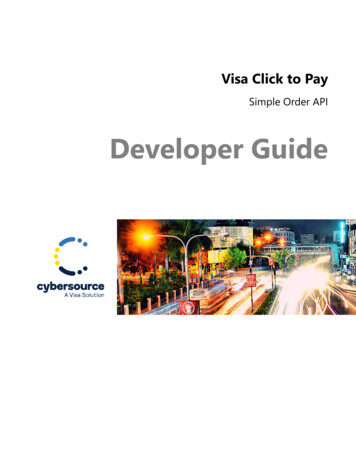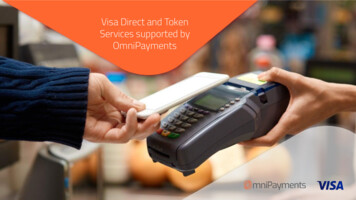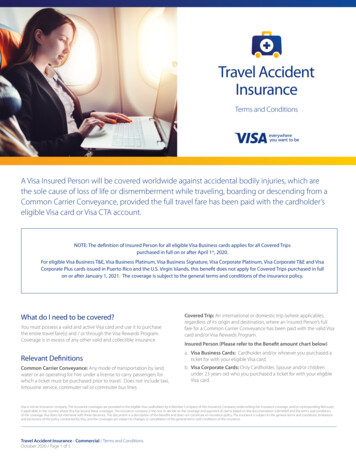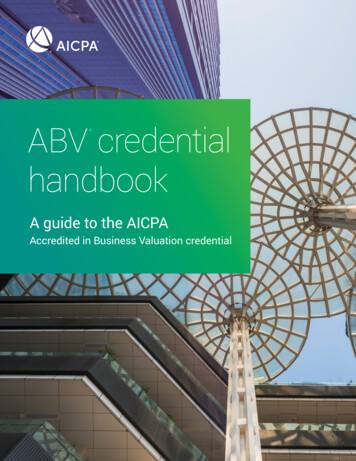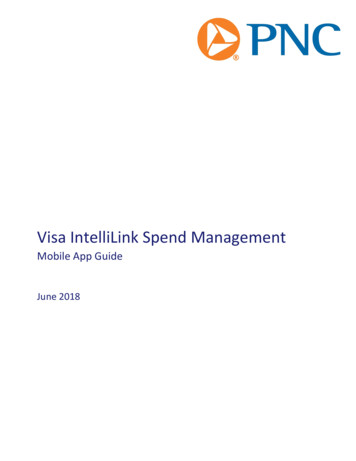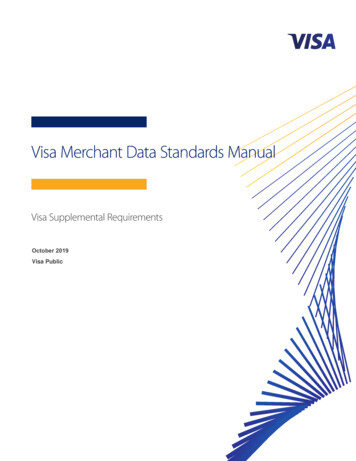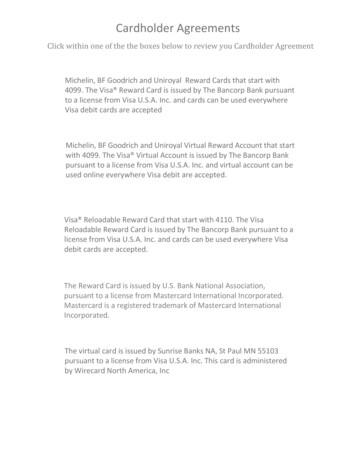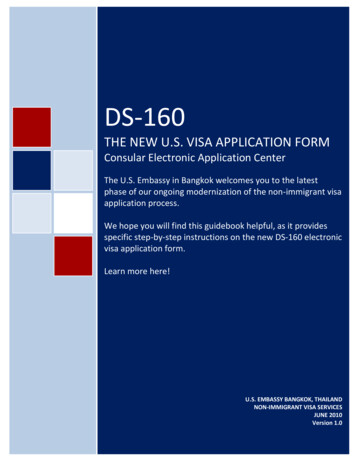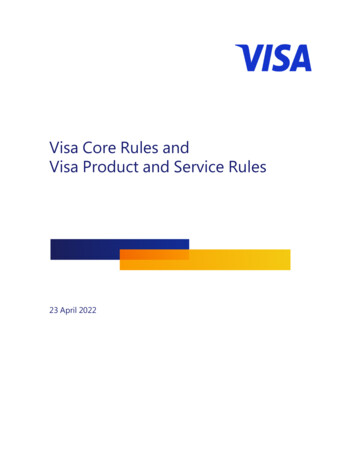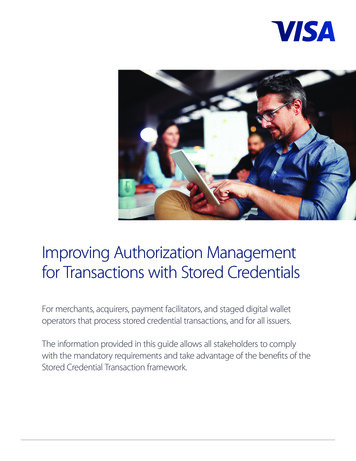
Transcription
Improving Authorization Managementfor Transactions with Stored CredentialsFor merchants, acquirers, payment facilitators, and staged digital walletoperators that process stored credential transactions, and for all issuers.The information provided in this guide allows all stakeholders to complywith the mandatory requirements and take advantage of the benefits of theStored Credential Transaction framework.
Table of ContentsIntroduction.3What is a Stored Credential?.4New Taxonomy for Stored Credential Transactions.5Stored Credential Terminology.6Summary of Requirements.8Global Stored Credential Transaction Framework Mandates.9Face-to-face Environment.10Card-absent Environment.11Use and Definition of Value “C” in the POS Environment Field.12Consent Agreement Provisions.13Additional Information.14Europe Additional Requirements.15For More Information.152Improving Authorization Management for Transactions with Stored Credentials
IntroductionVisa announced requirements for its Stored Credential Transaction framework, includingmandates to identify initial storage and subsequent use of payment credentials.What is aStored Credential?A stored credential isinformation (including, butChargebackRulesnot limitedto, an accountnumber or payment token)that is stored by a merchantor its agent, a paymentfacilitator, or a staged digitalwallet operator to processfuture transactions.What is aStored Credential?Chargeback RulesNote:There is no impact tochargeback rules as a resultof these stored credentialupdates.As the payment system has evolved, instances in which a transaction is initiated witha stored credential based on a cardholder’s consent for future use have increased tosignificant levels.Growth in digital commerce, together with the emergence of new business models, hasincreased the number of transactions where a merchant or its agent, a payment facilitator(PF), or a staged digital wallet operator (SDWO) uses cardholders’ payment credentials(i.e., account details) that they previously stored for future purchases.Recognizing stored credential transactions distinctly allows for greater visibility into thetransaction risk, enabling robust processing and resulting in differential treatment.Visa has defined authorization data values to help identify initial storage and usage ofstored payment credentials to enable differentiated processing.Visa is enhancing its rules and processing specifications to address a comprehensive list ofscenarios where payment credentials are stored with the merchant1.Note: Compliance with the Stored Credential Transaction framework is required to participatein Real Time Visa Account Updater 2. This service enables merchants to get updated cardinformation as part of the authorization message in real time, instead of the existing offlinebatch process.Benefits of Identifying Transactions as a Stored CredentialIdentifying stored credential transactions specifically, allows for differentiated treatmentthrough the authorization approval process. The results are: Greater visibility of transaction risk levels for issuers Results in higher authorization approval rates and completed sales Fewer customer complaints and improved cardholder experience Allows participation in Real Time Visa Account Updater Service3123Merchant refers to a merchant or its agent, a payment facilitator, or a staged digital wallet operator.Availability varies by region.Real Time Visa Account Updater expands VAU into VisaNet and enables real-time updates as part of the standardpurchase authorization process. It eliminates the pre-authorization step required by legacy VAU, thus eliminating thegap in time between current VAU and authorization transactions.Improving Authorization Management for Transactions with Stored Credentials3
What is a Stored Credential?Stored CredentialA stored credential is information (including, but not limited to, an account number orpayment token) that is stored by a merchant or its agent, PF, or SDWO to process futurepurchases for a cardholder.Payment credentials received by merchants from third parties including pass-throughdigital wallets that are not stored by the merchant, its agent, or PF are not consideredstored credentials. For example, a payment credential received by a merchant on apurchase from Visa Checkout and not stored by that merchant, its agent, or PF is notconsidered a stored credential.A credential is also not considered a stored credential when the merchant or its agent,PF, or SDWO stores the credential to complete a single transaction or a single purchasefor a cardholder (including multiple authorizations related to that particular transaction).For example, when a cardholder provides a payment credential to a hotel to cover futurereservations and charges as part of the cardholder’s membership profile, it is considereda stored credential. However, when the cardholder provides the payment credential to ahotel to cover charges related to a specific reservation only, it is not.4Improving Authorization Management for Transactions with Stored Credentials
New Taxonomy for Stored Credential ransactions (CITs)Merchant-inititatedTransactions (MITs)Credential on ReauthorizationResubmissionDelayed ChargesNo ShowInstallmentsRecurringUnscheduledCredential on FileImproving Authorization Management for Transactions with Stored Credentials5
Stored Credential TerminologyCardholder-initiated Transaction (CIT): A cardholder-initiated transaction is any transaction where thecardholder is actively participating in the transaction. This can be either at a terminal in-store or through acheckout experience online, or with a stored credential.Credential on File CIT: A card-absent transaction initiated by the cardholder where the cardholder does not needto enter their card details as the merchant uses the payment credential previously stored by the cardholder toperform the transaction. Examples include a transaction using customer’s merchant profile or staged digital tion(MIT): Merchants commonly initiate MITs without the active participation of theRecurringUnscheduledInstallmentsCredential on Filecardholder to: Fixed-datesubscriptionsNo ShowDelayed Charges Perform a transaction as a follow-up to a cardholder-initiated transaction (CIT) Perform a pre-agreed standing instruction from the cardholder for the provision of goods or servicesExamples of MITs include: A hotel charge for mini-bar expenses tallied after the guest has checked out and closed the folio A subsequent recurring payment for a magazine subscriptionReauthorizationesubmissionDigital payment made via an app to purchase goods or order services at customer’s request—such as ordering a rideor buyingNotraintickets—arenot MITsbut are cardholder-initiatedas the cardholder actively participates in them.RecurringUnscheduledInstallmentsShowDelayed Charges Fixed-dateCredential on FilesubscriptionsIndustry-Specific Business PracticeMITs: MITs defined under this category are performed to fulfill a businesspractice as a follow-up to an original cardholder-merchant interaction that could not be completed withone single transaction. Not every industry practice merchant-initiated transaction is performed with a storedcredential. When the merchant or its agent, a payment facilitator, or a staged digital wallet operator stores thecredential for a single transaction or a single purchase, it is not considered as a stored credential transaction. Thefollowing transaction types are industry-specific transactions:Incremental: Incremental authorizations can be used to increase the total amount authorized if the authorizedamount is insufficient. An incremental authorization request may also be based on a revised estimate of what theUnscheduledInstallments doRecurringReauthorizationIncrementalNo Showauthorizationscardholdermay spend. Incrementalnot replace theoriginal authorization—they are additionalCredential on File Fixed-dateto previously authorizedamounts. The sum of all linkedsubscriptionsestimated and incremental authorizations represent theResubmissionDelayed Chargestotal amount authorized for a given transaction. An incremental authorization must be preceded by an estimated/initial authorization.One or more incremental authorizations can be requested while the transaction has not yet been finalized(submitted for clearing). Incremental authorizations must not be used once the original transaction has beensubmitted for clearing. In such a scenario, a new authorization must be requested, with the appropriate reasoncode (e.g., delayed charges, reauthorization).Resubmission: A merchant performs a resubmission in cases where it requested an authorization, but receiveda decline due to insufficient funds; however, the goods or services were already delivered to the rizationNo Show canMerchants in such scenariosresubmit therequest to recoveroutstanding debt from cardholders.crementalResubmission6Delayed Charges Fixed-datesubscriptionsImproving Authorization Management for Transactions with Stored CredentialsCredential on File
Stored Credential Terminology (continued)Reauthorization: A merchant initiates a reauthorization when the completion or fulfillment of the original order orservice extends beyond the authorization validity limit set by Visa.ReauthorizationsubmissionDelayed Charges Extended stay hotels, car rentals, and cruise lines. A reauthorization is used for stays, voyages, and/or rentals thatextend beyond the authorization validity period set by Visa.Delayed Charges: Delayed charges are performed to process a supplemental account charge after originalservices have been rendered and respective payment has been processed.No uledCredentialontoFilemake a guaranteed reservation with certain merchant segments.Fixed-dateNo Show: Cardholders canuse their VisacardsDelayed ChargessubscriptionsA guaranteed reservation ensures that the reservation will be honored and allows a merchant to perform a NoShow transactionto chargeUnscheduledthe cardholder a penalty according to the merchant’s cancellation policy.RecurringInstallmentsNo Showyed Chargesmentssubscriptions Split or delayed shipments at eCommerce retailers. A split shipment occurs when not all the goods ordered areavailable for shipment at the time of purchase. If the fulfillment of the goods takes place after the authorizationvalidity limit set by Visa, eCommerce merchants perform a separate authorization to ensure that consumer fundsare llmentsShowThere are Notwocommonreauthorizationscenarios:Credential on File Fixed-date Fixed-dateCredential on FileFor merchants subscriptionsthat accept token-based payment credentials to guarantee a reservation, it is necessary to performa CIT (Account Verification Service) at the time of reservation to be able perform a No Show transaction later.Standing-Instruction MITs: MITs defined under this category are performed to address pre-agreed standinginstructions from the cardholder for the provision of goods or services. The following transaction types arestanding instructions transactions:InstallmentsRecurring Fixed-datesubscriptionsInstallment Payments: A transaction in a series of transactions that use a stored credential and that representcardholder agreement for the merchant to initiate one or more future transactions over a period for a singlepurchaseor services.Recurring of goodsUnscheduled Fixed-dateCredential on FilesubscriptionsRecurringPayments: A transaction in a series of transactions that use a stored credential and that are processedat fixed, regular intervals (not to exceed one year between transactions), representing cardholder agreement forthemerchant to initiate future transactions for the purchase of goods or services provided at regular intervals.UnscheduledCredential on FileUnscheduled Credential on File (UCOF): A transaction using a stored credential for a fixed or variable amountthat does not occur on a scheduled or regularly occurring transaction date, where the cardholder has providedUnscheduled consent for the merchant to initiate one or more future transactions. An example of such transaction is anCredential on Fileaccount auto-top up transaction.Improving Authorization Management for Transactions with Stored Credentials7
Summary of RequirementsMerchants and their third-party agents, payment facilitators, or staged digital wallet operators that offercardholders the opportunity to store their credentials on file must: Obtain cardholder consent for initial storage of credentials Utilize appropriate data values (i.e., Stored Credential indicators as per the Stored Credential TransactionFramework) to identify initial storage and usage of stored payment credentialsBusiness Requirements for Processing Stored Credential No ShowInstallmentsEffective October 2016:Delayed ChargesRecurring Fixed-datesubscriptionsUnscheduledCredential on FileVisa updated and expanded existing rules related to requirements to cover all transactions under the new storedcredential transaction category.Effective October 2017:Merchants and their third-party agents, payment facilitators, or stored digital wallet operators that offer cardholdersthe opportunity to store their credentials on file must: Disclose to cardholders how those credentials will be used. Obtain cardholders’ consent to store the credentials. Notify cardholders when any changes are made to the terms of use. Inform the issuer via a transaction that payment credentials are now stored on file. Identify transactions with appropriate indicators when using stored credentials.Please refer to the October 2016 and April 2017 Visa Global Technical Letter and Implementation Guide and Visa Rulesfor complete details and to ensure compliance by the effective dates.Disclosure requirements and indicator usage as per the Stored Credential Transaction Framework:Effective with the 14 October 2017 VisaNet Business Enhancements Release, compliance with bothdisclosure requirements and usage of correct indicators is mandatory.8Improving Authorization Management for Transactions with Stored Credentials
Global Stored Credential Transaction Framework MandatesEffective October 2017 GloballyIn an effort to align requirements globally, effective 14 October 2017, Visa requires: When capturing a stored credential for the first time, a merchant or its agent, a PF, or SDWO must: Follow all cardholder disclosure and consent requirements specified in the Visa Rules. Submit a payment transaction (authorization/full financial) to Visa if an amount is due at the time credentialsare stored. If no amount is due at the time credentials are stored, the merchant or its agent, a PF, or anSDWO must submit an Account Verification authorization.Note: This requirement already exists for recurring and installment transactions in the Europe region. Identify in the payment transaction or Account Verification authorization that the credential isbeing stored: If the credential is being stored for cardholder-initiated, stored credential transactions or forUnscheduled Credential-on-File (UCOF) transactions, the merchant or its agent, a PF, or an SDWO mustsubmit the value “C” in the POS Environment field. If the payment credential is being stored for a recurring or installment relationship, the merchant orits agent, a PF, or an SDWO must submit the transaction with the existing value of “R” or “I,”respectively in the POS Environment field.Note: If either the first payment or the Account Verification authorization is declined, the credential cannotbe considered a stored credential, and the merchant must not use the credential for any subsequent transactions. When initiating a transaction using a stored credential, the merchant or its agent, a PF, or an SDWO mustsubmit the payment transaction with a value “10” in the POS Entry Mode Code field. Value “10” indicates thecredential presented is a stored credential.This applies to card-absent transactions using stored credentials, including transactions that are: Performed with primary account numbers (PANs) or payment tokens. Initiated by a cardholder for purchases of goods or services with payment credentials already stored by themerchant or its agent, a PF, or an SDWO. Initiated by the merchant without active participation of the cardholder: Based on standing instructions with the cardholder (i.e., recurring, installment and UCOF transactions).Standing instruction transactions for recurring, installment or UCOF transactions must be submittedwith an “R,” “I,” or “C,” respectively, in the POS Environment field.OR For industry-specific business practice MITs such as incremental payments, no shows, delayed charges,reauthorization, or resubmission where the credentials were previously stored for future purchases (andnot to complete that specific transaction only).Note: Subsequent merchant-initiated recurring, installment, or UCOF standing-instruction transactions must alwaysbe submitted with a POS Entry Mode Code of “10.” Standing-instruction transactions are only permitted whencredentials are stored on file.4Merchant refers to a merchant or its agent, a payment facilitator, or a staged digital wallet operator.Improving Authorization Management for Transactions with Stored Credentials9
Face-to-face EnvironmentThe following two tables highlight the correct POS Entry Mode Codes and POS Environment field values for initial andsubsequent cardholder-initiated transactions (CITs) and merchant-initiated transactions (MITs):Paymentcard orpass-throughFace-to-facedigital walletat merchantPOS terminal10Subsequent Transactions(Card-Absent Environment)MITC, R, or I(asappropriate)YesStanding InstructionIndustry Practice10Field notpresentPOS Entry Mode(Industry Practice orStanding Instruction)POS EnvironmentPOS EnvironmentPOS EnvironmentPOS Entry ModeCITPOS Entry ModeMerchantor its agentor PFDoes Storage of CredentialMandate Apply?First TransactionStorage of Credential forFuture TransactionsForm FactorEnvironmentFirst TransactionSetting10Field notpresentC if UCOF,R if recurring,or I ifinstallment01(any validvalue forincrementalexcept 10)Field notpresentN/A(transactionnotpermitted)07, 90,91, 01Notstored bymerchantor its agentor PFNoImprove Your Authorization Management For Transactions With Stored CredentialsField notpresentNo subsequenttransaction with astored credential
Card-absent EnvironmentThe following two tables highlight the correct POS Entry Mode Codes for initial and subsequent cardholder-initiatedtransactions (CITs) and merchant-initiated transactions (MITs):Standing Instruction10Field notpresent10Field notpresentC if UCOF,R if recurring,or I ifinstallmentField notpresent01(subsequenttransactionwith a storedcredential notpermitted)Field notpresent01(any validvalue forincrementalexcept 10)Field notpresentN/A(transactionnotpermitted)C, R, or I(asappropriate)10Field notpresent10Field notpresentC if UCOF,R if recurring,or I ifinstallmentIndustry PracticeC, R, or I(asappropriate)POS Entry Mode(Industry Practice orStanding Instruction)POS EnvironmentPOS Entry ModeYesPOS EnvironmentPOS EnvironmentSDWOMerchantor its agentor PFMITCITPOS Entry ModeCardabsentDoes Storage of CredentialMandate Apply?Merchantprofile orpass-throughdigital wallet(online ormobile)Subsequent Transactions(Card-Absent Environment)First TransactionStorage of Credential forFuture TransactionsForm FactorEnvironmentFirst TransactionSetting01Not storedby merchantor its agentor PFNoSDWOYes01Improve Your Authorization Management For Transactions With Stored Credentials11
Use and Definition of Value “C” in the POSEnvironment Field“C.”The value “C” in POS Environment field indicates one of the following: The merchant or its agent, a PF, or an SDWO is storing the payment credential for the first time for subsequentcardholder-initiated transactions. The merchant or its agent, a PF, or an SDWO is storing the payment credential for the first time for subsequentUCOF transactions. The merchant or its agent, a PF, or an SDWO is submitting an UCOF transaction, which is initiated based onstanding instructions with the cardholder. UCOF transactions are triggered by events that do not occur at ascheduled interval—for example, a cardholder sets up a reload of their account with the merchant based onusage thresholds, which does not occur at regular intervals5.Note: Use value “10” for the POS Entry Mode Code and value “C” for the POS Environment field in the same transactiononly if it is an UCOF transaction. Cardholder-initiated, stored credential transactions must only use the POS Entry ModeCode value “10” and no POS Environment field.Note: For Visa card transactions that are not processed by VisaNet, processors may use other values and/or fields for thepurposes listed above, as long as specific indicators are used.512When a standing instruction transaction is initiated at regular intervals, the recurring transaction indicator “R” should be used.Improving Authorization Management for Transactions with Stored Credentials
Consent Agreement ProvisionsDisclosure tocardholder andcardholder consent6Note:Retroactive identification andcardholder consent and disclosureagreement are not required forcredentials stored prior to 14October 2017. However, effective14 October 2017, a merchantor its agent, a PF, or an SDWOmust submit all stored credentialtransactions with a value of “10”in the POS Entry Mode Codefield, including transactions forcredentials stored prior to this date.Handling andstorage requirementsPrior to storing credentials for future use, the merchant or its agent, the payment facilitator, orthe staged digital wallet operator must establish an agreement with the cardholder.Basic Requirements: Truncated version of the stored credentials (i.e., last four digits of PAN) How the cardholder will be notified of any changes to the consent agreement The expiration date of the consent agreement, if applicable How the stored credential will be usedAdditional Requirements:If the cardholder is providing consent to the merchant or its agent, a payment facilitator, or astaged digital wallet operator to initiate transactions using stored credentials. Cancellation and refund policies Location of merchant Transaction amount or how it will be calculated Convenience fee or surcharge (if permitted and applicable) The frequency (recurring) or event (unscheduled) that will prompt the transaction For installment payments, the total purchase price and terms of future payments, including the dates, amounts, and currencyBasic Requirements: Notify the cardholder in the event of a change to the agreement Retain the agreement for duration of the consent; provide it to the issuer upon request Where required by applicable laws or regulations, provide to the cardholder a record of the consentDo not complete a transaction: Beyond the duration expressly agreed by the cardholder, or If the cardholder requests that the merchant or its agent, a payment facilitator, or a staged digital wallet operator change the payment method, or If the cardholder cancels according to the agreed cancellation policy, or If the merchant or its agent, a payment facilitator, or a staged digital wallet operator receives a decline responseOtherrequirementsAuthentication:For a transaction using a stored credential initiated by the cardholder, the merchant or itsagent must validate the cardholder’s identity before processing. Local regulations and lawsmust be followed as appropriate.Receipts:Receipts must be provided for installments; if the cardholder cancels the installment withinthe terms of the cancellation policy, within three business days the merchant or its agent, apayment facilitator, or a staged digital wallet operator must provide cancellation or refundconfirmation in writing and credit transaction receipt for the amount specified in thecancellation policy.6Not applicable to no show, delayed charge, incremental authorization, resubmission, reauthorization.Improving Authorization Management for Transactions with Stored Credentials13
Additional InformationExisting storedcredentialsRetroactive identification and cardholder consent and disclosure agreement are not required forcredentials stored prior to 14 October 2017. However, effective 14 October 2017, a merchant orits agent, a PF or an SDWO must submit all stored credential transactions with a value of “10” inthe POS Entry Mode Code field, including transactions for credentials stored prior to this date.Stored credentialwith third partiesCredentials can be on file with the merchant, its agent, a payment facilitator, or a staged digitalwallet operator. If the merchant is unsure whether payment credentials were in storage, the storedcredential indicator should not be used. For example, this would apply when a hotel booking hasbeen made through an online travel agent.“Guest” checkout withadditional charges(industry-specificpractices)If guest7 checkout is utilized but payment credentials are provided/stored to cover additionalrelated charges associated with solely that transaction—i.e., split shipments, delayed hotelcharges—Stored Credential indicators should not be used.Declined initialtransactionIf the initial transaction (in which storage of credentials is communicated) is declined for anyreason, the merchant should not consider the credential to be on file for the purpose of theStored Credential indicator.When is the credentialconsidered stored?Once the merchant has: Followed all disclosure requirements; and Used the appropriate indicator in the authorization message to: Indicate that the credential is being stored, and Request and receive approval on the authorization for the initial transactionNote: When a merchant does not take any payment at the time of storing the credential on file, themerchant must submit an Account Verification transaction.When is the credentialNOT considered stored?A credential is not considered stored when the merchant or its agent stores the credential tocomplete a single transaction or a single purchase (including multiple authorizations related tothe particular transaction). For example, when a cardholder provides a payment credential to ahotel to cover future reservations and charges as part of the cardholder’s membership profile, it isconsidered a stored credential. However, when the cardholder provides the payment credentialto a hotel to cover charges related to a specific reservation only, it is not.Also, payment credentials received by merchants from third parties including pass-throughdigital wallets that are not stored by the merchant, its agent, or PF are not considered storedcredentials. For example, a payment credential received by a merchant on a purchase from VisaCheckout and not stored by that merchant, its agent, or PF is not considered a stored credential.714A cardholder is considered checking out as a “guest” when he or she completes an online transaction without registeringor logging in.Improving Authorization Management for Transactions with Stored Credentials
Europe Additional RequirementsEffective October 2017Additional acquirer/merchant requirements for stored credentials used for the purpose of merchant-initiated transactionsin Europe.Merchant-InitiatedTransactionsin EuropeProvide notification for recurring transactions (seven business days) and for Unscheduled COFtransactions (two business days) before any of the following:Card VerificationValue RequirementsAn issuer must not decline a transaction based solely on a missing CVV2, if the authorizationrequest is for the subsequent transaction after the credential is stored. This rule previouslyapplied only to recurring transactions and is now applicable to: End of trial period More than six months have elapsed since the previous transaction in the series Any change to the agreement including date, amount, or how it is calculated RecurringInstallmentUnscheduled COF (UCOF)Transactions initiated by the cardholder using a stored credentialFor More InformationAP, Canada, CEM
6 Improving Authorization Management for Transactions with Stored Credentials Cardholder-initiated Transaction (CIT): A cardholder-initiated transaction is any transaction where the cardholder is actively participating in the transaction. This can be either at a terminal in-store or through a
